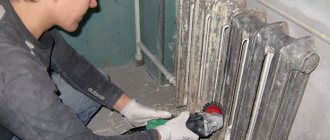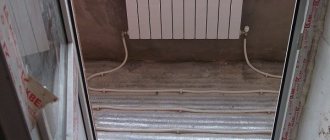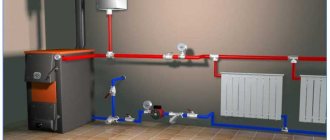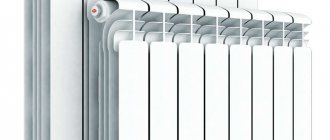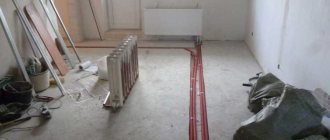Heating radiators provide comfortable temperature conditions in the apartment during the cold season. Traditionally, steel and cast iron heating devices were installed during the construction of a house and connected directly to the pipeline, without shut-off valves. In such situations, replacing batteries in an apartment involves additional hassle.
Replacing heating batteries in an apartment
Reasons for replacement
There are a number of reasons why heating appliances in an apartment building have to be changed. These include:
- Physical wear and tear of equipment
. Old batteries deteriorate, lose their tightness, and during pressure testing of the system after emergency or seasonal maintenance work, or simply during operation, they leak. - Insufficient heating
. An old radiator differs from a new one in a thick layer of deposits inside the housing, which is why the coolant cannot fully transfer heat to the room. - Insufficient power
. In multi-apartment panel buildings, convectors can be installed, the power of which is not enough to fully heat large rooms. - Unattractive appearance
. The battery can be replaced for aesthetic reasons - modern models have an attractive, stylish design.
After making a decision to install new heating devices instead of physically or morally outdated ones, it is necessary to determine who will finance and carry out the work - the management company or the owner of the apartment.
Old cast iron battery
Types of heating batteries
Currently, you can find on sale both the already familiar cast-iron batteries and more modern ones - aluminum, bimetallic or steel radiators. Let's take a closer look at each type.
Cast iron
It is worth noting that modern cast iron batteries are completely different from those produced several decades ago. First of all, they are distinguished by their beautiful appearance and variety - you can choose options for both a modern interior and a retro style. The main advantage for which products from this group are valued is their resistance to aggressive external and internal environments. Moreover, products from foreign manufacturers are produced with smooth internal walls. This greatly facilitates the circulation of the coolant and prevents the formation of limescale.
Bimetallic
This type of battery is made from two different metal alloys. The internal part of the structure is made of steel, so it can experience loads of up to 40 bar and is not afraid of water hammer. The external contour of the radiator is made of aluminum coated with enamel, which ensures high-quality heat transfer from the device.
In addition, due to uniform heating of the surface, the heat-transfer area reaches significant sizes. Another advantage of this type of battery is that it has a laconic and modern appearance, so it won’t be difficult to fit them into the interior.
Steel
There are several types of steel radiators:
- tubular;
- sectional;
- panel.
This type of heating devices is distinguished by a wide variety of model designs, as well as high efficiency in closed systems with high-quality coolants. If you decide to choose it to replace central heating batteries in your apartment, it is worth considering that such devices are quite sensitive to aggressive environments and sudden temperature changes. Their weakest points are the welds. However, they can still be used provided that a reducer is installed on each radiator. This device will allow you to equalize the pressure level and avoid excessive load on the metal case, thereby extending the life of the radiator.
Whose responsibility is it to replace heating radiators in an apartment?
Let's figure out who should change the batteries in a privatized apartment. In accordance with Decree of the Government of the Russian Federation No. 491 (came into force in August 2006), the entire heating system in an apartment building is classified as common property. Its composition (according to paragraph No. 6 of the Rules) includes heating network equipment, risers, valves (shut-off and for regulation), general house heat meters, as well as heating devices (radiators).
Accordingly, in the event of physical wear and tear of the batteries, leaks or overgrowth from the inside, the replacement of heating radiators in the apartment is carried out by the management company (ZhEK), to whose account residents receive monthly deductions for major repairs. It is the management company that is responsible for the maintenance and servicing of common property, part of which is the heating radiators in the apartments.
In practice, it is easier to achieve free replacement of emergency heating appliances in a municipal apartment. Housing office workers often force residents of privatized apartments to independently purchase a battery and pay for dismantling and installation work. But in accordance with current legislation, the purchase of a heating device and all work on its installation must be paid for from money collected for major repairs of the housing stock, regardless of whether the apartment is privatized or not.
In an effort to save money, management companies prefer to repair old batteries until they begin to crumble. Therefore, it may take a lot of effort to achieve free installation of new radiators to replace emergency ones.
Emergency heating radiator
If residents decide to install a new, modern heating device to replace an obsolete but serviceable one, they will have to resolve this issue on their own by paying for the purchase and installation.
Installation of new radiators
It's time to install new radiators on the wall. For the batteries I purchased, it was possible to purchase separately either a set for mounting to a brick wall (with hooks), or a universal set (with mounting angles and screws). Since in my case one wall is inter-apartment wooden plastered, and the other two are load-bearing brick, I took both sets. When attaching radiators, it is necessary to take into account the permissible distances to walls, floors and window sills specified in the radiator passport, and also provide access to shut-off and control valves.
After installing the fasteners, you need to prepare the radiator for connection, namely, install plugs and adapters. On one side of the radiator, adapters for connecting to the valves are mounted, on the other, on top, an air release valve (Mayevsky valve) and a plug at the bottom. It is very important to install an air release valve on each battery. The fact is that aluminum radiators are more sensitive to water hammer than cast iron ones, so they must be additionally protected (for example, from sudden pressure changes during pressure testing, which plumbers carry out before the heating season).
| Air release valve on the heating radiator | New assembled heating radiator |
I installed a control valve on the adapter at the top of the battery. It can be mounted both vertically and horizontally - you just need to determine how it is more convenient to use it. You should buy high-quality valves with the ability to install a thermal head on them (the price difference between such valves and simple ones is small). That’s what I did: I recently bought and installed an automatic thermal head. Installation took 3 minutes without stopping the system. I installed a shut-off valve on the lower adapter, which is closed (opened) with a hex key (it is only needed to dismantle the radiator).
| Shut-off valve on the bottom adapter | Control valve with thermal head |
This is easy to do: you just need to close the shut-off valve and the control valve, unscrew the union nuts on the adapters and remove the radiator. Installation of valves at this stage is preliminary. This is only necessary for subsequent adjustment of the metal-plastic pipe. It is better to cut it with a special tool. My advice: do not try to cut this pipe with a grinder or a hacksaw - this is inconvenient and impractical, since the cut will end up with burrs and you will have to process it with a file. It is better to get a special cutter. If you are not going to work with metal-plastic pipes in the future, you can buy the cheapest cutter - it costs 50-100 rubles and will definitely be enough for a hundred cuts. If you plan to update your country or apartment water supply, or your friends often ask for help, you can purchase a professional cutter for 200-500 rubles.
Cutter for metal-plastic pipes | Cutter for metal-plastic pipes |
So, taking a metal-plastic pipe, I put on it a crimp nut and a collet from the adapter fitting at the shut-off ball valve and pushed the pipe onto the fitting tightly, until it stops. Next, I moved the collet, not reaching 2 mm from the end of the pipe, and carefully screwed on the nut.
It must be remembered that this connection is “disposable” - it cannot be disassembled and remade! Therefore, I do not recommend overtightening the nut. And if a leak appears, the nut can be tightened.
After that, I brought the pipe to the battery, bending it in the right places. You can bend the pipe slightly with your hands, without any tools. If you need to bend it strongly, then it is better to buy and use a special spring insert - in this case the pipe will not bend. The spring is removed after the fitting is complete.
Spring for bending metal-plastic pipes
Having brought the pipe in, I cut it off with a small margin (about 5 mm). Then I removed the control valve from the battery and fixed the pipe on its adapter, as described above. (Don’t forget to put the nut and collet on the pipe first!) After that, I also fixed the lower pipe to the shut-off valve fitting, hung the battery in place and connected it to the system with union nuts. That's all, actually.
Shut-off ball valves can be eliminated from my system. To remove the radiator, it will be enough to close the control and shut-off valves. But I did not do this, because I was afraid of the tightness of the connections between the fittings and the metal-plastic pipe. If they leak, I can always turn off the ball valves and repair the liner.
Replacement of heating devices through the housing office
So, replacement of heating devices is carried out through the housing office only in situations where the established service life of the radiators has been exceeded, they are in disrepair and cannot be repaired. In other cases, when batteries leak, minor repairs are performed.
According to current standards, the service life of a cast iron radiator is 15-30 years when used in an open system and 30-40 years when used in a closed system. But, even if we are talking about an apartment building where the batteries were installed more than 40 years ago, the operating company is often limited to only repairing the radiator, since replacement is included in the list of major repairs, the timing of which may not yet be determined.
Replacing the battery using gas welding
To replace emergency batteries free of charge, residents must contact the Housing Office with a corresponding application. It is recommended to prepare two copies of the application and mark both as having been accepted by the responsible person at the housing office. The application and its copy are marked with the number, date and legible signature of the responsible person.
Duplicating the document will help if problems arise in the future related to the reluctance of the management company to change emergency batteries at the expense of the capital repair budget. But residents must defend their rights, since they paid for the replacement of old radiators through monthly payments for housing, maintenance and major repairs of the common property of the house.
Procedure time
It will take approximately 2.5 hours to change the batteries.
If you have the necessary equipment and experience in handling it, you can replace heating devices quickly and efficiently.
Calculation for one product:
- drafting - 10 min;
- cutting off supply and return - 5 minutes;
- removal and removal of the old radiator - 5 minutes;
- installation of a heat shield - 15 min;
- installation of brackets - 10-15 minutes;
- assembly of the circuit with a ball valve - 40-60 minutes;
- fastening the Mayevsky crane - 5 min;
- connection of wiring - 10 min;
- assembly quality check - 10 min.
It will take no more than 2.5 hours to replace the battery in one room. For repairs in a standard two-room apartment, 8 hours are enough, including a lunch break.
Coordination of replacement of system elements
Replacing the heating system in an apartment requires approval from the utility company. You must obtain permission by contacting the administration of the operating organization servicing the house.
Even at the design stage of an apartment building, the heating system is calculated - the number and power of heating devices, their location, volume and temperature of the coolant, etc. are determined. Replacing heating batteries with models with different performance characteristics may result in deterioration of the heating system in the house. If unauthorized replacement heating batteries do not meet the design parameters, this provokes an emergency situation.
Removing the battery from the brackets
If you plan to change the heating radiators in the apartment yourself - at your own expense, you will need to submit a number of documents for consideration
:
- Application with attached technical passport for the apartment.
- A document confirming ownership of the apartment.
- Expertise-approved thermal calculations for new heating appliances.
- Certificates of conformity for all components (radiators, fittings, pipes, fittings, etc.).
Note! If the radiator is replaced with a similar heating device, permission is not required. In this case, the management company is only warned about the work being carried out.
Thermal calculation expertise is required if you plan to:
- change heating batteries by installing devices of a different type, with different technical characteristics;
- increase the power of the existing radiator by adding links;
- move the heating device to another part of the room.
An expert should check whether upgrading the heating system will not disrupt the thermal balance of the house. The examination is a paid service and is performed at the expense of the apartment owner.
From the moment the documents are submitted to the management organization until the permit is issued, it can take up to 2 months. After receiving permission, you must submit an application to turn off the riser and drain the coolant from the corresponding section of the system.
After replacing the heating batteries in the apartment, an application for technical examination is submitted - specialists and representatives of the management company check the correct installation and compliance of the heating devices with those that were approved for installation.
Replacing heating radiators
A radiator is a heating device with channels through which coolant passes. There are many reasons for replacing a radiator: they have rotted from old age and are leaking water in small streams. Such problems can arise from mechanical impact (impact). They do not provide the expected warmth and cannot withstand pressure - the fault is due to mineral deposits on the inner walls of the radiators themselves. This can lead to reduced clearance in the radiator.
Heating radiators in apartments are replaced more often than in private homes. In private homes, the owner can independently regulate the supply. This cannot be done in apartments, so you have to put up with what you have or install a convector. There are also thermostats for sale that can be installed in apartments and regulate the heat yourself.
When unscheduled replacement of radiators occurs, the cost of dismantling and installation increases. The best time to replace radiators is the off-season. The system, as a rule, is in a passive state, and permission to replace it will be much easier to obtain.
Types of radiators:
- Panel. Such radiators heat up faster than other types of batteries. Bottom or side connection. The battery is made of rolled steel.
- Columnar. Batteries of two collectors connected to each other by tubular columns. The materials for the manufacture of such radiators are aluminum and steel.
- Sectional batteries. Consist of two or more hollow sections. You can make an unlimited number of sections on a radiator; their number depends on the area of the room. You also need to take into account the weight of the entire structure so that the fastenings can withstand the entire load. Batteries can be made of cast iron, steel, aluminum and bimetal.
It doesn’t matter whether you replace heating radiators yourself or hire workers, you should always choose the best equipment
What is important to pay attention to?
The equipment passport indicates the test and operating pressure
You should pay attention to the operating data; in cases of force majeure, there will be a reserve of test pressure
Why is pressure so important? When heat is supplied to the 9th floor, the pressure is 6 atmospheres, and when supplied to the 23rd floor - 15 atmospheres. Not all types of radiators can withstand such pressure; those made of aluminum are eliminated immediately
In the private sector, it would be wise to install aluminum batteries, since high pressure is not required to supply coolant. In nine-story buildings, cast iron batteries are mainly used. They can easily withstand a working pressure of 9 atmospheres. If the pressure supply is higher, then in this case you need to install radiators made of high quality steel or bimetal
Not all types of radiators can withstand such pressure; those made of aluminum are eliminated immediately. In the private sector, it would be wise to install aluminum batteries, since high pressure is not required to supply coolant. In nine-story buildings, cast iron batteries are mainly used. They can easily withstand a working pressure of 9 atmospheres. If the pressure supply is higher, then in this case you need to install radiators made of high quality steel or bimetal.
Corrosion resistance is a very important factor when choosing equipment. Batteries that are almost resistant to corrosion include cast iron. Aluminum batteries are considered the weakest according to this criterion. If the choice is made of aluminum radiators, then be prepared for the fact that you need to fill in anti-corrosion agents.
The most common reason for replacement is low heat transfer. Therefore, when choosing a radiator, this indicator plays an important role. The documents upon purchase indicate the power of one section. To calculate how many sections you need for a room, remember that 1 m2 requires a power of 80–120 watts.
Convenient time for work
The period of time when it is better to change heating batteries is the period between the end of one heating period and the beginning of another. During the heating interval, hydraulic tests of the system can be carried out. It is important to obtain information in advance from the management company about the timing of the tests in order to schedule battery replacement for other days.
It is better to change radiators in the summer
Due to an emergency situation, it may be necessary to quickly change heating devices. For a privatized apartment, emergency replacement of radiators is a paid service, since their performance must be monitored by the owner of the apartment and promptly notified to the operating company about leaks or physical wear and tear of old batteries that have expired.
The heating system is leaking - what to do?
During the heating season, a leak from the heat exchanger will lead to more serious consequences. As soon as it appears, you must immediately notify the management office (housing office).
The battery is leaking - service organizations must replace it with a new one immediately . In this case, the apartment owner does not bear any expenses.
Read here when water meters should be changed.
If you refuse to replace the batteries under such conditions, you should contact the Housing Inspectorate with a complaint against the management company (Housing Office) that they are refusing to fulfill their direct duties.
Detection of leaks after the end of the heating season , which are possible when water is not drained from the system, is eliminated within an extended time frame.
Residents submit a request to the management company (housing office), which describes the problematic situation.
Specialists decide whether it is possible to repair the radiator or replace the battery. If residents are apartment owners, they finance the purchase of heating devices.
We change batteries ourselves
Before replacing the heating device with a new one, decide on the scope of work. If the battery is connected to horizontal pipes that come out of the wall, only the heating device itself is changed. In other cases, it is desirable to replace the riser so as not to cut metal pipes.
To replace the riser, you will need to negotiate with the neighbors above and below the floor - in this case, the pipeline is connected to their heating devices. If the neighbors do not want to start repairs, you can choose one of three options:
- cut the riser from top and bottom, cut external threads and install a new pipeline from modern materials;
- cut off the supply pipes next to the old radiator and connect the new heating device to the old pipeline;
- cut the supply pipes at the bend and connect new supply pipes with a bypass to the vertical sections of the riser.
Replacing heating radiators using welding
Steel pipes require installation using gas welding, for which you should hire professionals with the appropriate equipment. When installing a heating radiator yourself, it is more convenient to use metal-plastic pipes (a prerequisite is press fittings, not threaded connections), galvanized steel frames with installation on bends, corrugated or ordinary stainless steel pipes.
Removing old batteries
Before changing the batteries in the apartment, it is important to make sure that the management company employees have shut off the coolant supply and emptied the riser. Residents replacing radiators should have a convenient container ready to drain any remaining water from the radiator during dismantling.
If a decision is made to replace the heating radiator along with the riser or only with the supply pipes, then the pipeline is simply cut in the selected places. In the case when a new battery is installed to replace the old one, the heating device is removed according to the following scheme
:
- twist the locknut on the drive until it stops (it is what secures the battery), the operation is performed on the upper and lower connections;
- determine the cutting locations on the supply pipes, and it is necessary to leave at least a centimeter of thread;
- marks are made using a level - the cut must be vertical and even, otherwise it will be difficult to install a new battery;
- cut the pipes according to the marks and remove the battery to be replaced from the wall brackets;
- remove the brackets;
- If necessary, the edges of threaded pipes are trimmed by tightening the locknut and removing burrs.
Removing the old plate battery
Preparation for installation
At the stage of preparing to modernize the heating system in an apartment with your own hands, you should develop a connection diagram, determine the length and diameter of all sections of the pipeline, the number and type of components. The list of materials used must be approved by the specialists issuing permission to replace the battery. The scheme necessarily provides for the installation of shut-off valves on the supply line and a bypass - a jumper that allows you to turn off the radiator without blocking the flow of coolant in the house system.
Work on installing a new radiator begins after the location of the heating device has been determined:
- the gap between the floor and the lower edge of the radiator is at least 10-15 cm;
- distance from the top edge of the battery to the window sill - from 15 cm;
- a gap of 3-4 cm is left between the wall and the housing of the heating device (adjustable when installing the brackets).
Pipes, taps, fittings for battery installation
Note! Failure to comply with the recommended distances impairs the circulation of heated air and reduces the thermal efficiency of the radiator.
Installing a new battery
If the heating system riser has been dismantled, first of all, external threads are cut on the protruding parts of the old pipes for fastening steel or metal-plastic pipes using appropriate fittings. A bypass jumper is installed between the supply and return pipes using tees. After the bypass, a ball valve with an American connection is mounted on each of the horizontal pipes.
Threaded connections are sealed with flax strands and silicone sealant (or oil paint). This sealing option is allowed for connecting cast iron radiators; unlike FUM tape or thread, the seal is not squeezed out or torn. Sealants that do not dry out tend to squeeze out, while sealants that harden tend to dry out, causing the battery to leak.
Installing a new battery
To connect a heating device to the system yourself, you must adhere to a certain work technology
:
- Assemble the radiator. The lower unused hole is closed with a standard plug, and a Mayevsky tap is mounted on the upper pipe (the drainer will help remove the air lock when filling a new heating device).
- Foot nuts with right-hand and left-hand threads are installed on the radiator inlets, using paronite seals for sealing (rubber seals can dry out and crack when exposed to high temperatures).
- The radiator is installed on a stand of suitable height so that the adapter nuts can be connected to the American ones on the ball valves.
- After fitting, markings are made on the wall for installing brackets, holes are drilled and all four fasteners are mounted. To ensure that the battery is secured correctly, check the position of the brackets with a level - it should be horizontal.
- The radiator is connected to the supply pipes (it is important to properly seal all connections) and hung on brackets.
Upon completion of the work, representatives of the management organization fill the system with coolant - at this stage, the tightness of the connections and the heating device itself is checked. Using the Mayevsky tap, bleed the air from the battery when filling the system. To do this, use a special key or screwdriver to turn a special element. When a trickle of water flows from the hole, close the tap.
Note! To replace radiators in the entire apartment, you need to turn off each involved riser one by one, and you need to notify the management company.
Replacing heating risers
When all the tools are prepared and the system is empty, replacing heating radiators with your own hands begins with dismantling the old batteries and pipes. The work is carried out using a grinder with a metal cutting wheel installed. In order not to stain the wall, a thin sheet of asbestos or other non-combustible material must be inserted between it and the pipe.
Advice. Do not rush to cut the riser right away; start by dismantling the heating device and supply pipelines. Then cut off the pipes from the neighbors' side and carefully remove them from your apartment, cutting the riser into 2 parts.
Since the outer diameter of the metal-plastic pipeline is larger than that of steel, there is a possibility that you will have to remove old pass-through cases (sleeves) from the ceilings and install new ones. Then you need to cut the thread, screw on the adapter and attach a new plastic pipe, pushing it through the ceiling. If the neighbors did not allow you to carry out the work, then you will have to do everything in your apartment. But it should be remembered that a pipe that is too old can break off in the ceiling during threading, so it must be held with a gas wrench.
The next step is installing a new battery. It is unlikely that the old fasteners will be suitable for this, so they must be removed and new ones installed, having first marked the position of the radiator on the wall. When fixing the radiator, you need to align the horizontal level. It is recommended to carry out work on marking and installing the heating device, taking into account the distances indicated in the diagram:
Now all that remains is to connect the radiator to the new riser using metal-plastic connections. For single-pipe wiring, which is most often found in multi-story buildings, a jumper (bypass) should be installed between these connections, as is done in the diagram:
Important. A bypass is required in a single-pipe scheme, even if it did not exist before. Old-style steel convectors did not create much resistance and did not take away as much heat as modern batteries, which is why jumpers were not installed on them.
Replacing heating batteries in an apartment - at whose expense and in what cases? 2021
As autumn approaches, people are thinking about insulating their homes. And then the problem of heating it becomes urgent.
It's good if your apartment receives enough heat through central heating devices to feel comfortable in the cold. But when it is not enough due to low thermal power or leaking radiators, it becomes necessary to replace the batteries.
It would seem that everything is simple - take the money and change it, but from the point of view of Russian legislation, not everything is so simple. And a lot of questions arise: at whose expense should the heating batteries in the apartment be replaced - through the housing office or with your own hands?
Who should change pipes in a privatized or municipal apartment? Most owners of privatized apartments do not even think about the fact that not the entire apartment is their property. For example, according to the provisions of the Housing Code of the Russian Federation, walls, roofs and transit communications (including batteries) are common property. This means that financial responsibility for their condition falls on the shoulders of the management company servicing the house.
So homeowners are not at all obliged to pay for the necessary replacement of radiators. However, there is a small subtlety here: the radiator ceases to be considered a common property if it can be separated from the riser using a locking device - a jumper. But if the jumper is missing, then the tenant can count on free replacement of the heating batteries in the apartment.
In addition, due to the ownership of common property by all owners, the latter can collectively decide to replace the batteries for an additional fee, which must be specified in the relevant clause of the management agreement.
As for citizens renting housing from the state, they are subject to the same rule, or more precisely, the same “Rules for the maintenance of common property in an apartment building,” approved by Decree of the Government of the Russian Federation of August 13, 2006 No. 491, paragraph 6.
It lists the items of common property: an intra-house heating system, including risers, heating elements and shut-off valves that regulate them, as well as other equipment on these networks.
This legal act classifies the heating system as a common property, the repair and replacement of which, according to the same law, is paid by the management company from funds accrued under the article “Routine repairs and maintenance of the house,” with the exception of work carried out as part of a major overhaul of the heating system of the house generally.
Therefore, if a heating radiator does not have a shut-off valve, then tenants do not have to pay for the purchase of a radiator and its replacement.
If there is a valve, replacing the heating batteries in the apartment will be considered routine repairs, and, according to clause 4 of the social tenancy agreement, this is carried out at the expense of the tenant. In particular, the contract states that the tenant is obliged to monitor the serviceability and safety of the equipment inside the apartment and make routine repairs to the premises “at his own expense.”
The list of repair work also includes “repair of in-house engineering equipment,” including the heat supply system.
By defining a heating radiator as common property, the law limits the ability of a tenant or apartment owner to independently replace radiators. This creates many obstacles in the path of a person who decides to replace the radiator in an apartment without the help of a management company.
According to Articles 44 and 46 of the Housing Code of the Russian Federation, the battery, being part of common property, can only be replaced by a decision of all shareholders at a general meeting. Otherwise, replacing pipes and heating radiators in the apartment will be interpreted as unauthorized disposal of common property. And this imposes personal liability on the violator of the rules in the event of an accident in the heating system.
Moreover, interference may also arise from the HOA, which often requires coordination with them for the installation of an additional heating element in the apartment or a change in its configuration. The HOA is inclined to consider this as a re-equipment, notes about which should be included in the technical passport of the premises. Whereas in reality, battery replacement is not reflected in the data sheet. In addition, it is worth knowing that replacing heating batteries in an apartment should be carried out, if possible, in the summer or before the heating is turned on.
Despite all the legal obstacles, it is often much easier to replace the battery yourself than to legally obtain the same from the management company.
In response to your request to replace the central heating batteries in the apartment, utility workers may refer to the clause “on the balance sheet distinction” between common and private property, according to which the owner himself is responsible for the repair and maintenance of the batteries.
Therefore, if the central heating batteries in your apartment require replacement (and there is no jumper on them), and the management company refuses to pay for this procedure, then write an official letter to the organization servicing the house demanding to change the batteries . And, having studied the legal side of the issue, get ready to defend your case in court. And to save heat, you can always install heat meters in your apartment.
If the apartment has old radiators, then replacing them will cost a decent amount .
At whose expense should the batteries in the owners' apartments be replaced, and who will be responsible in the event of an emergency after a leak?
We will tell you in the article how to replace the heating battery in an apartment through the housing office.
Dear readers! Our articles talk about typical ways to resolve legal issues, but each case is unique.
If you want to find out how to solve your particular problem, please contact the online consultant form on the right or call the free consultation numbers:
Is it possible not to pay rent, and what happens if debt accumulates? Find out the answer right now.
The issue of property ownership of heating devices in an apartment is complex.
In accordance with Part 1 of Art. 36 of the Housing Code of the Russian Federation, plumbing and other equipment are considered common goods in apartment buildings , but only on the condition that this equipment serves more than one room.
Part 1 of Art. says the same. 290 Civil Code of the Russian Federation.
RF PP dated August 13, 2006 No. 491 introduced the Rules for the maintenance of common property in apartment buildings into a legislative act, so in paragraph 6 of these Rules... it is specified that the in-house heating system with risers, radiators, all fittings, heat meters, etc. refers to common property.
But in paragraph 5 it is clarified that only everything that is located before the valve located on the outlet from the riser towards the apartment will be considered common.
Thus, if apartment radiators can be disconnected from the entire system, then they cannot be considered a common property . In the absence of such a valve, indoor radiators are part of the general heating system.
There is a clear answer to the question of who should pay for replacing radiators in an apartment, and this answer is: the owner must pay .
If the housing is privatized, then when replacing normally working heating devices with a more modern option, the owner must pay, as well as when batteries are not considered common property .
In a situation where apartment batteries belong to common property, their replacement must be made at the expense of funds contributed by all owners under the article “maintenance and repair of common property.”
This is interesting: Electricity tariff in rural areas 2021
Municipal housing is transferred for use under a social contract. rental, therefore the owner, that is, the municipality .
You can learn about the size of the fine for smoking in the entrances of residential buildings from our article.
The owner must replace heating appliances that are working normally .
Situations with heating equipment can be very different, and the procedure differs, depending on the circumstances. But it is important to remember that resident intervention is unacceptable: it is important that professional plumbers .
If during the heating season one or more of them leak, then this situation may be considered a pre-emergency situation (water as a coolant is under pressure in the heating system, which is fraught with flooding of apartments along the riser), which is the responsibility of the management company to eliminate by replacing the leaky device with a new one.
This statement is also confirmed by the Rules and Regulations of those. exploitation of housing stock, approved. RF PP No. 170.
A leak in a cast iron radiator is a malfunction that must be eliminated immediately after receiving a signal from the residents, using the forces and means of the management company. Having discovered a leak, the apartment owner must, without wasting a minute, notify the organization servicing the apartment building.
The management company, homeowners association, housing office or other service company is obliged to respond immediately and eliminate the problem, preventing the development of a large-scale accident.
An example of a complaint to the management company about replacing heating radiators.
If heating radiators leak after stopping the supply of heat to the MKD, the malfunction should still be eliminated, but not in such a severe mode. A battery leak indicates that water has not been drained from the system . The procedure is as follows:
- Residents report the problem to the management company.
- Management company employees fix the leak, if possible, or change the battery at the expense of funds donated by the owners.
Only a specialist servicing an apartment building can quickly shut off the riser or cut off the heating from the entire entrance.
how to replace the heating riser from housing and communal services in the video:
In the event of an emergency, all responsibility lies with the technical service of the management company, homeowners association or housing office.
In this situation, it most often turns out that scheduled inspections of the general household facilities , there was no testing of the system, as a result of which a leaky pipe and radiator were inspected.
How to calculate ODN for electricity according to the established standard? Read about it here.
If the replacement of radiators does not take place as part of a campaign for planned or major repairs of apartment buildings, but is an initiative of the residents, then both the purchase of materials and the work will be carried out at the expense of the apartment users themselves . It is important to realize that unauthorized actions with the heating system are unacceptable.
It is impossible to do without a management company or housing office, but this does not mean that local plumbers need to be hired to carry out the work.
It is more logical to find a reliable contractor specializing in san. those. works, but not only an excellent reputation and the presence of recommendations from friends are important, you need to check permits, including proof of membership in an SRO for this particular type of work and services.
After choosing a contractor, you must contact the management company. The employee and the management company can also carry out work, but it is unlikely to be quick.
applications are submitted to the Criminal Code :
- about replacement of heating devices;
- regarding turning off the riser and removing water.
If the first appeal is submitted with the aim of obtaining approval in principle for a replacement and determination of deadlines, then the second is directly for the execution of work.
applications for temporary shutdown of the riser.
How much does it cost to replace radiators? For dismantling and installing one radiator they charge from 2,500 rubles. up to 4000 thousand rubles. (excluding the cost of the batteries themselves). This amount also includes related operations, such as garbage removal.
Benefits exist for the following categories of residents:
- large families;
- disabled people;
- pensioners, etc.
In practice, obtaining benefits for plumbing services is not easy. If contractors are involved in the work, they are unlikely to be interested in the cramped circumstances of the customers.
If the work is carried out by the management company, then you can really count on benefits : the management company has all the papers about the availability of benefits, subsidies and other payment concessions.
What are the timing and frequency of checking gas equipment in residential buildings? You will find the answer on our website.
Do I need to coordinate the replacement or relocation of radiators in the apartment and with whom?
Replacing, let alone moving, radiators without approval should really not be done , especially if it is planned to replace the batteries with a completely different design or increase the number of sections.
These actions are qualified as a violation of the rules for the use of common property, which is managed by the service company (clause 5.2.5 of the Rules...).
It is necessary to apply the planned changes to the apartment plan and contact the management company with the chief engineer or technical director, operation engineer, and agree with these officials.
It is possible that you will need to contact the heating supplier: this is where specialists will be able to perform thermal engineering calculations and issue recommendations in the form of a simple project.
Thermal balance is a certain balance between the heat entering the apartment building and heat loss through walls, ceilings, windows, floors, cracks and various cold bridges. Manipulating batteries can really upset this balance , and the rooms can become cool or, conversely, hot.
When the topic of the urgent need to replace existing radiators with new ones is being intensively discussed, then someone is interested in selling radiators or in providing paid services that amount to a round sum on the scale of apartment buildings.
The management company has the right to make a decision on a total change of heating devices at a general meeting of premises owners .
Before bringing such a question to the attention of the owners, it is necessary to carry out a series of calculations with an economic justification in favor of one or another option.
Replacing batteries is an issue that cannot be resolved without the intervention of management officials. Even if apartment radiators can be disconnected from the riser and considered the property of the apartment owner, these devices are still involved in the overall heat supply system .
Read about the procedure for notifying about power outages in an apartment for non-payment here.
At whose expense is it necessary to change the batteries in the apartment? About this in the video:
Didn't find the answer to your question? Find out how to solve exactly your problem - call right now:
It's fast and free!
The beginning of the heating season can bring unpleasant surprises in the form of faulty radiators of the heating system. In this case, the temperature in the premises drops to unacceptable levels, and residents experience serious discomfort. Not all owners understand who should change the heating batteries in the apartment if they no longer serve their intended purpose. The answer to this question depends on who owns the apartment, as well as on the reason for replacing the radiators.
At first glance, the heating system of an apartment building is not much different from the method of heating other types of housing. However, it has its own nuances. It starts with inlet valves that cut off the house from the heating main. Along the flange closest to the external wall, there is a division of the areas of responsibility of the management company and the service provider. This important point helps in due course to determine who should replace the heating in an apartment building.
This is interesting: What is the IPU indication in the housing and communal services receipt for 2021
In addition to batteries, bottlings and risers, the system includes:
- hot water taps on the supply and return pipelines (one or two);
- a heating elevator that supplies hotter water through a nozzle into the socket, and through a suction, takes part of the water from the return pipeline into a repeated cycle into the heating circuit. The diameter of the nozzle regulates the temperature of the mixture and radiators;
Issues related to the operation and maintenance of common property, as well as the list of equipment and systems included in its composition, are regulated by the Housing Code of the Russian Federation and Decree of the Government of the Russian Federation dated August 13, 2006 No. 491.
Due to constant disputes about who should replace faulty radiators and other elements of the heating system in apartment buildings, the Ministry of Construction of Russia sent out letter No. 9506-АЧ/04 dated 04/01/2016, in which it clarified whether apartment heating radiators are the common or personal property of the owners and, therefore, how to change heating batteries.
According to this letter and the provisions of legislative acts, the in-house heating system includes:
- risers;
- heating elements;
- shut-off and control valves;
- ODPU heat energy;
- other equipment located on these networks.
Despite the apparent unambiguity of the position regarding heating radiators and their belonging to common property, expressed in regulatory documents, it does not always turn out to be fair.
So, only batteries serving more than one residential premises, including those without shut-off valves, which are located on branches from the risers of the intra-house heating system and are located inside the apartments, are considered common property.
Almost every resident sooner or later is faced with the need to replace old radiators. One of the main reasons is loss of tightness due to metal corrosion. Mechanical damage is also caused by pressure surges in the central heating network.
A decrease in battery power is another reason to update heating devices. Due to the poor quality of the coolant, solid deposits form on the internal surfaces of the system. This leads to a narrowing of the channels through which the coolant circulates, and therefore the power of the devices decreases.
Often, the capabilities of heating devices, the parameters of which were calculated according to old standards, are not enough to heat an apartment in a high-rise building.
If, after launching and debugging the heating system, the radiators in the apartment remain cold, and the heat supply agreement was not signed directly with the service provider, you should file a claim with the service organization (MC or HOA).
The document, drawn up in 2 copies, informs the management company that the temperature in the home does not meet established standards.
In response to a complaint, a representative of the management company must draw up a report on non-provision or poor quality of service.
If consensus is not reached, a representative of the housing inspection and an independent specialist should be invited to re-inspect. The results of the inspection are documented in a special act, 2 copies of which must be signed by all those present.
If the Criminal Code has left the claim unanswered, you should contact:
- State Housing Inspectorate of the region;
- regional branch of the Federal Service for Supervision of Consumer Rights Protection (Rospotrebnadzor);
- local body of the Federal Antimonopoly Service.
If the problem of cold batteries can only be solved by replacing them, residents want to find out who should change the heating radiators. In such a situation, there may be several options. The choice of the preferred method is related to the following aspects:
- Who owns the apartment?
- where such batteries are installed;
- what are the reasons for the proposed replacement of heaters.
From these data follows the answer to an equally important question for the owner, at whose expense the heating radiators in the apartment are replaced.
Municipal apartments are residential premises owned by the municipality and rented out to them under a social tenancy agreement.
Art. 67 of the Housing Code obliges the tenant to maintain the dwelling in proper condition, including carrying out routine repairs. The contract lists the parameters that distinguish it from capital. The systems that need to be repaired include heating.
From the text of the standard agreement it follows who repairs heating radiators in a non-privatized apartment. This responsibility clearly rests with the tenant.
However, there are exceptions to the rule. They concern the following cases:
- carrying out work to repair important elements of common property or included in the equipment of apartment buildings;
- carrying out major home repairs, including replacing the heating system.
Since large-scale renovations are required to be carried out by the owner, replacement of heating batteries in an apartment for major repairs is carried out at the expense of the owner, that is, the municipality.
In situations that allow for different interpretations, only a court can often put an end to disputes between the tenant and the landlord, if neither party wants to interpret the provisions of the standard agreement or articles of the Housing Code in favor of the opponent.
If the parties are not ready to peacefully determine at whose expense the replacement of batteries in a municipal apartment should be carried out, the most compelling argument will be a court decision.
If an apartment in an apartment building is privately owned, the owner of the property pays monthly for utilities, as well as for activities related to the maintenance of common property. If there is a need to replace radiators, he may be interested in whether the management company should change the batteries in the apartments.
Art. 167 of the Housing Code of the Russian Federation, as well as the Rules approved by the Government of the Russian Federation, determine the list of objects that belong to common property. These include equipment and communications serving all or part of the apartments in the house, including heating systems.
The Housing Code of the Russian Federation classifies all objects that are located inside the apartment and cannot be used by other residents of the house as personal.
Consequently, to the question of who should change heating radiators in a privatized apartment, we find a clear answer in the legislation: all work on their maintenance must be carried out by the owner.
If the management company intends to carry out a planned overhaul of the apartment building, then as part of these measures the heating system, including heating equipment in the owners’ apartments, can be completely replaced. In this situation, it is clear at whose expense the batteries in a privatized apartment are replaced - the work is financed from the funds of the management company.
If an accident occurs in an apartment due to a leak in the heating radiators, or a pre-emergency situation occurs with a minor leak in the radiators, the homeowner must immediately notify the service company about this. This step is a mandatory component of how to replace heating batteries in an apartment through the housing office in 2021.
According to the law, in this case, the management company, housing office or homeowners association must deal with the elimination of the emergency situation with the subsequent replacement of heating devices installed in the apartment in the apartment building.
Moreover, service organizations are obliged to carry out all necessary work free of charge. This is one of the cases when free replacement of heating batteries in an apartment through the housing office is quite possible. After receiving information from the owner about the accident, in order to prevent more serious consequences, the damage should be immediately eliminated at the expense of the forces and means of the management company.
After the management company accepts the claim to replace the radiators, we can assume that the owner of the home with an emergency radiator has resolved the issue of how to change the batteries through the housing office for free.
If residents decide to update the batteries not because of an emergency, but only out of a desire to improve their appearance or performance characteristics, they can do this themselves, but with the direct participation of the management company.
Despite the fact that these works are not within the competence of the management company, contacting specialists will help you figure out how to properly change heating batteries.
Unauthorized intervention in the heating system can disrupt its operation, and the one who took unauthorized actions will have to answer for this.
To do everything according to the rules, you need to find an organization that will replace the radiators. She must have a license or SRO certificate of approval to carry out this type of work.
After installing the batteries, a representative of the management company will conduct a technical examination and sign an act of registration of new heating devices.
Before you begin replacing radiators, you should obtain permission from the management company to carry out such work. To do this you need to provide:
- statement;
- registration certificate of the premises where the replacement will be carried out;
- title documents for the apartment;
- certificate that the contractor is included in the Unified State Register of Legal Entities.
It usually takes about 2 months to review documents. After this, permission is signed to turn off the riser and drain the coolant from the heating system. The document specifies the time and maximum duration of the work.
Often the management company offers paid work or tries to shift the replacement of emergency batteries to the owner of the premises. In such a situation, the owner can file a complaint with the Housing Inspectorate. It should indicate that responsible persons are avoiding the performance of direct duties.
Replacing batteries in an apartment is a troublesome undertaking, which, depending on the reasons, may be the responsibility of the owner, tenant or service company. The legislation of the Russian Federation helps determine in what case and who is obliged to carry out work and finance it.
Lawyer. Member of the Bar Association of St. Petersburg. More than 10 years of experience. Graduated from St. Petersburg State University. I specialize in civil, family, housing, and land law.
The question of who should change the heating batteries in an apartment becomes especially acute with the onset of cold weather. After all, if the battery leaks or there is not enough heat in the house, replacement cannot be avoided. In this article we will figure out who owns the batteries in the apartment and at whose expense they are replaced.
Government Decree No. 491 of August 13, 2006 determined the composition of property that is considered common. According to this regulatory act, the common property of an in-house heating system includes:
- risers;
- heating elements;
- control and shut-off valves;
- collective heat metering devices;
- other equipment located on these networks.
However, when the need arises to change the batteries in an apartment (especially in a privatized one), both the owner and the management company interpret the legislation in their own interests. Due to regular judicial appeals, the need arose to clarify the normative act.
Dear readers! We cover standard methods for solving legal problems, but your case may be unique. We will help you find a solution to your problem for free
— simply call our legal consultant at:
It's fast and free ! You can also quickly get an answer through the consultant form on the website.
To clarify the controversial situations, the Ministry of Regional Development of the Russian Federation sent letter No. 6037-RM/07 dated April 4, 2007, in which batteries in apartments are recognized as included in the common property of the building. Of course, it is not in the interests of the management company to convey this information to the owners of privatized apartments. Therefore, homeowners are often forced to replace the battery in their apartment at their own expense.
Since batteries in an apartment are recognized as the common property of an apartment building, financial responsibility for their replacement or repair falls on the management organization. But there is one nuance here too.
If there is a tap on the branch from the riser of the common house system, with which you can turn off the system in the apartment, then battery maintenance becomes the responsibility of the owner.
In all other cases (it doesn’t matter whether your apartment is municipal or privatized), repairs and replacement of heating equipment are carried out at the expense of the management company. Payment comes from the accounting item “Routine repairs and maintenance of the house.”
Simply put, if your battery is leaking, the management company will replace it. You need to call a specialist, and he is obliged to replace the device free of charge.
It would seem nothing complicated. But in practice, things often happen differently. The management company's employees may say that they do not have a replacement battery. They may offer to repair the old device or install plugs and ask you to wait. This wait usually drags on. Therefore, the owner cannot stand it and purchases a battery at his own expense, because no one wants to freeze in the cold season.
If you nevertheless changed the battery in the apartment at your own expense, you have the right to demand compensation from the management company through the court. However, practice shows that such disputes are rarely resolved in favor of the owner. If you find yourself in this situation, it is advisable to contact a lawyer for professional help.
What should an owner or tenant do under a social tenancy agreement if the batteries in the apartment are in working order, but are obsolete? In this case, you can replace them only at your own expense, since the management company is not obliged to do this.
This is where difficulties arise. Since the battery in your apartment is a common property, the tenant’s ability to replace it himself is limited by law.
In accordance with Art. 44 and art. 46 of the Housing Code of the Russian Federation, the battery, being part of the common property, can be replaced only with the consent of all owners at the meeting.
If you ignore this fact, replacing the battery in the apartment will be regarded as unauthorized disposal of common property, which entails certain liability for the violator. For example, if an emergency occurs, the owner who has unauthorizedly replaced the batteries will eliminate the consequences of the emergency at his own expense. What to do?
The first thing you need to do before replacing the battery in your apartment is to coordinate such actions with the management company.
- If the radiators are replaced with similar ones, it is enough to notify the management company. No additional approvals will be required.
- If the batteries are replaced with heating devices that imply a change in configuration or an increase in the heating area, then in addition to notifying the management company, an examination will be required. In some cases, installing new radiators has a negative impact on the heat balance of the house. An expert will be able to determine the possibility of installation. The examination is carried out at the expense of the apartment owner.
- If you plan to move heating equipment, you will also need an expert opinion.
Who changes the batteries in the apartment? The owner can do this himself, contact a third-party company, or call a specialist from the management company. It is recommended to contact a “local” specialist. This way, in the event of an accident that results in damage to other residents, you cannot be blamed for incorrect installation. Accordingly, financial liability for emergency consequences will not overtake you.
»
Other
The battery is cold but the riser is hot: causes of the problem and ways to fix it 2021
Read more
Other
Water in the basement of an apartment building: what to do and where to go 2021
Read more
Great article 0



